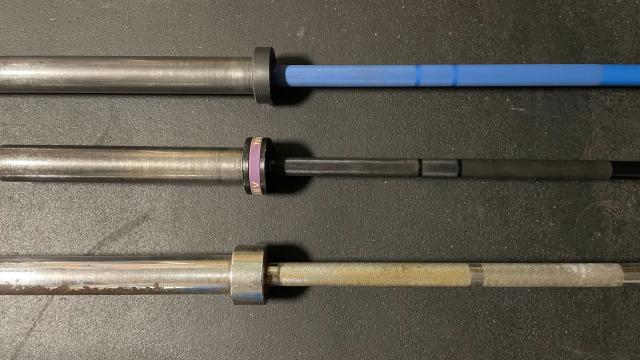Look closely at your barbell the next time you’re in a gym. Much of the surface is roughed up with a diamond pattern. This is called the knurling, and it helps your grip. But near the ends of the handle, you’ll see a ring or line of smooth metal on each side. Maybe two on each side, actually. These aren’t just for decoration; they have a purpose.
If a bar has two sets of rings, one is for weightlifting and one is for powerlifting
As we’ll see in a moment, there are two different strength sports that each call for their own markings near the end of the bar. Olympic weightlifting uses marks that are 91 centimeters apart from each other; powerlifting traditionally uses marks that are 81 centimeters apart.
In a regular ol’ gym, where nobody is competing in anything, you might see either set of rings — or both. It’s common for gym barbells to have both sets of knurl marks (or “rings,” as they’re often called). This Rogue 2.0 bar, for example, has both. The innermost rings are the powerlifting ones; the outermost rings are for Olympic weightlifting.
For bench press, your hands should be on or within the rings
On a bar that is made for powerlifting, the rings are there to define the widest legal hand position for the bench press. (These are the inner rings if your bar has both.) According to the International Powerlifting Federation’s technical rules:
The spacing of the hands [for the bench press] shall not exceed 81 cm measured between the forefingers (both forefingers must be within the 81 cm marks and the whole of the forefingers must be in contact with the 81 cm marks if maximum grip is used).
Those “81 cm marks” are the smooth lines in the knurling, and this rule is exactly why barbells used in powerlifting are manufactured with them.
Under these powerlifting rules, your hands may be placed to the inside of those rings, or they may be touching those rings, but it would be illegal in competition for your hands to be spaced so wide as to be outside the rings. Besides their use in competition judging, it’s common to describe your preferred grip for bench press in terms of these marks: For example, you might say that you bench “with pinky fingers on the rings.”
In some federations, like USPA, a different bar may be used for bench press than for the other lifts (squat and deadlift) but they all have those 81 cm marks. In the other lifts, they don’t matter to the rules, but the marks are still there for convenience. For example, you might be in the habit of putting your hands just outside those marks when you squat.
What does this mean if you’re not a competitive powerlifter, but just a person benching in your local gym for fun and/or to get jacked? Nothing significant, just that if you were to grip wider than the rings, some bro passing by might be like “yo dude, that’s a really wide grip,” and they would be right.
Still, you probably end up using those rings just to make sure you’re setting up the same way every time. We call the rings and other features of the bar “landmarks” because they help you get into the habit of placing your hands in the same spot every time.
The marks on weightlifting bars are only there as landmarks
In Olympic weightlifting, there is no rule about where you may place your hands. But the knurling marks are still standardised across bars for convenience. Otherwise, there would be a lot of distance between the smooth centre section and the end of the bar, making it hard to set your hands evenly and consistently.
This is especially important in the snatch, a lift done with a wide grip. When I set up for snatches, I put my hands just wide enough that the skin between my thumb and forefinger touches the rings. Someone with longer arms than me might prefer to be a thumb’s-length to the outside of the rings. Someone with shorter arms might want their hands on or even inside of the rings.
The rings are in the same place on men’s and women’s bars, by the way; both of these bars are the same length with the marks in the same place. (Their measurements only differ in the diameter of the handle and the length of the sleeves.)
If you do snatches and other Olympic lifts, the only thing you need to know about the rings is that some of your training bars might have those dual knurling marks, as described above. “Your” rings are the ones on the outside. This is handy to know when visiting gyms you’re not used to, or borrowing a bar that is marked differently than the one you have at home.

Leave a Reply
You must be logged in to post a comment.